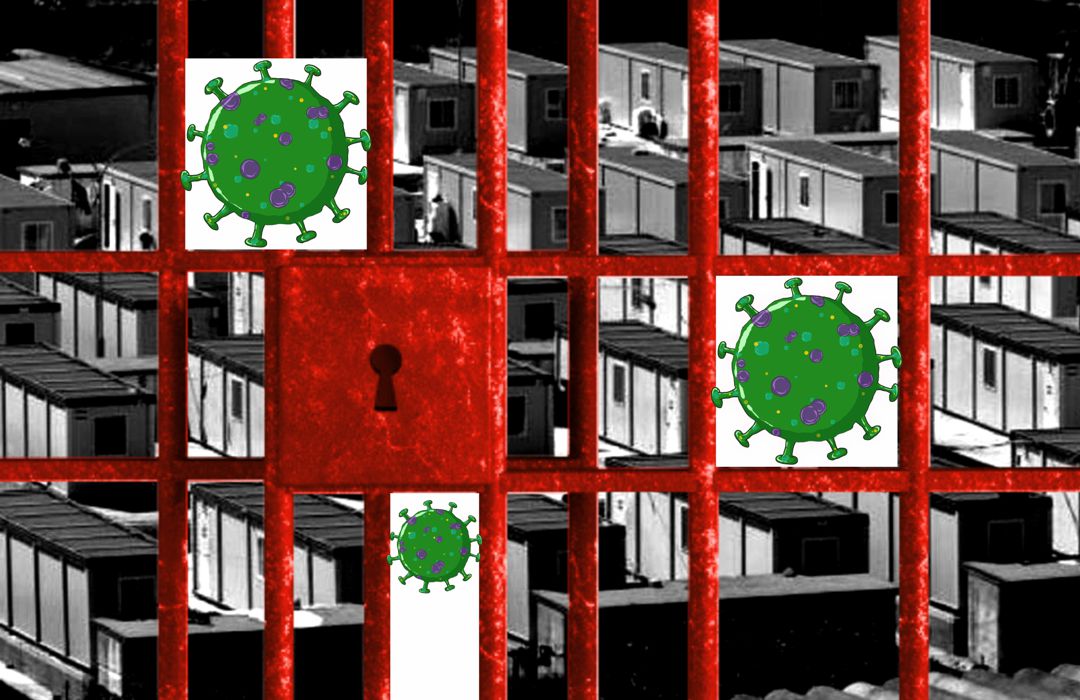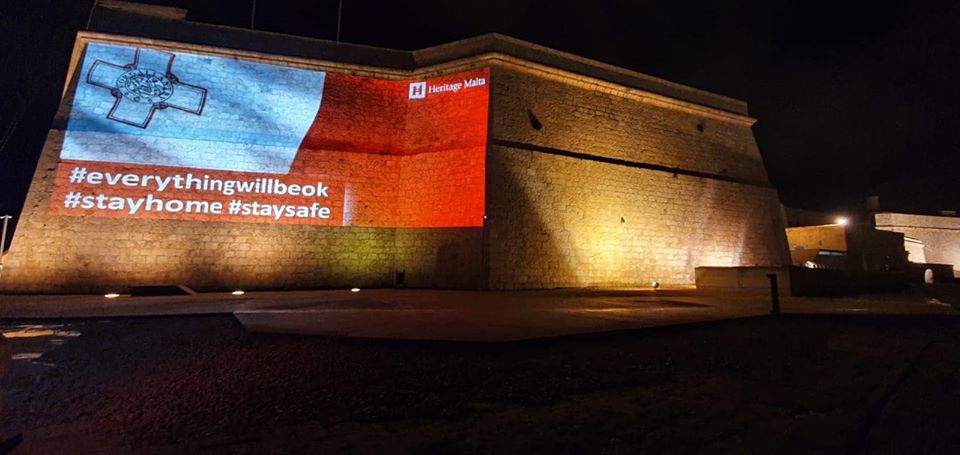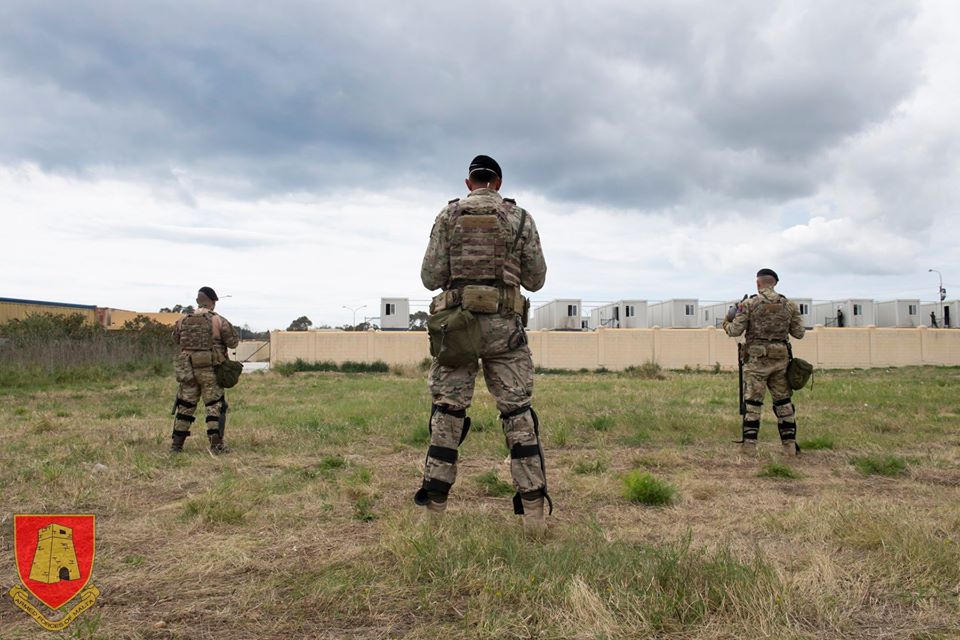
The armed presence along the perimeter of Ħal Far—essentially, the border between ‘us’ and ‘them’—was a display of state power and a pretense of care for its loyal citizens. At once, it disciplined the diseased ‘other’ and fenced the rest off from it.
by Krista Bonello Rutter Giappone and Daniel Vella
Collage by the IotL Magazine
[dropcap]“[/dropcap]We are all in this together,” the Secretary-General of the United Nations António Guterres declared in one of his speeches. It may be a comforting thought to suppose that, at the very least, our basic sense of helplessness in the face of the pandemic is shared. After all, we are alike in our vulnerability to the virus.
However, the assumptions of togetherness, shared vulnerability and helplessness that have become so commonplace are regularly contradicted by facts. As some authors have observed, the current crisis is rather exacerbating the inequalities in our society, proving that we are, indeed, “not all in it together”. ‘Solidarity’ is an empty word, if not based on efforts to ensure more equitable conditions which would enable a truly collective response.
Not All in it Together: Ħal Far Open Centre vs Everyone Else
It is evident that some of us have better living conditions and thus are better equipped to minimise both the risk of becoming infected and the economic repercussions this crisis has already induced, and which will most likely persist.
Some of us have the possibility to work from home—again, in varying conditions, depending on what ‘home’ means in terms of space and carework—and are still receiving a monthly paycheck without having to constantly worry about our income being affected by the crisis. Some of us are able to retreat to a comfortable home we can call our own, and where we can safely isolate ourselves. Some of us have balconies, gardens or rooftops that let us enjoy sunlight and fresh air without exposing ourselves to risk. Some of us have established personal support networks on which we can rely if needed.
This relative comfort contrasts starkly with the conditions of numerous others; in Malta, particularly exemplified by those forced to live in the Ħal Far open centre.
Even before the pandemic, the centre’s residents were cut off from key infrastructure and the rest of the community. Even the location of the ‘centre’, which is by no means central, enforces the segregation of its inhabitants. Not only does this minimise the possibility for any meaningful interaction between residents and the wider community, but it also leads to particularly long commutes for people who do not own private cars.
Even before the pandemic, the Ħal Far open centre’s residents were cut off from key infrastructure and the rest of the community.
The inhabitants are forced to live in overcrowded and unsanitary conditions that fall short of the minimum required for a comfortable way of life, offering very little in the way of privacy or personal space—the attributes often associated with the ‘home’ we are now all asked to retreat to.

All of the above aggravate the economic and social divide between ‘us’ locals and ‘them’ migrants in the most conspicuous way. Such conditions refute any affirmations by the state representatives that declare migrants and refugees as integral or equal members of Maltese society. By housing a group of people in a segregated space, inequality is enacted through geographical realities.
In the present crisis, the inadequacy of the open centre as a residential space becomes all the more obvious. The fear, precarity, and uncertainty that we all feel when faced with a health risk are intensified here. In such crowded conditions, physical distancing is simply not possible for the centre’s residents. In addition, the physical and ideological discrimination becomes more poignant.
It is true that, thanks to the efforts of the International Red Cross, suspected cases are investigated, and those with confirmed infections are isolated in a hastily-put-together field hospital.
The efforts of people at the centre, donors and NGOs supplying humanitarian aid make conditions more tolerable. Still, the outcome of the centre’s inherently inadequate conditions has been entirely predictable—the rate of infection in the open centre’s population is disproportionately higher than that of the country’s population as a whole. As of 28th April, the number of confirmed cases at Ħal Far stood at 48, out of 458 cases countrywide—that is 10.4 percent of the total.
As of 28th April, the number of confirmed cases at Ħal Far stood at 48, out of 458 cases countrywide—that is 10.4 percent of the total.
What does the authorities’ decision to put more than a thousand of Ħal Far residents on lockdown—a decision which was not taken with regard to any other community in which positive cases were identified—tell us?
The disparity in treatment of the local population and Ħal Far residents calls out the myth of a shared togetherness in the face of the pandemic. Not only are ‘we’ not in this together, but this ‘we’ quickly became a policed category, which clearly does not include everyone in Malta.
Statements like “of the eight new cases, five were from the Ħal Far open centre for migrants and refugees, which is currently under lockdown” in the national media are meant as reassurance for the general population. These announcements imply that those infected at Ħal Far are isolated from the rest and thus cannot harm the wider community. Some comments even suggested that the cases at the open centre should be subtracted from the total or counted separately. The centre, therefore, is treated as a separate territory rather than part of the country.
Given the extent to which the virus had probably already spread among the centre’s population at the time when quarantine was imposed, the decision was taken in the interest of those outside the centre, not the centre’s inhabitants. The measure exposed contrasting attitudes, formally adopted by the authorities: care must be reserved for ‘us’, Maltese, who must stay safe and be protected from ‘them’, the non-Maltese inhabitants of the centre. In practice, locking down more than a thousand persons in crowded conditions turned the centre into a zone of contagion.
Had the centre’s inhabitants been deemed as part of Malta’s population, protective measures would have applied to them too. Extensive testing would have been carried out to immediately identify and isolate carriers, given the inevitability of contact within its walls. Even better, the centre’s residents could have been relocated to schools, hotels, or other currently vacant buildings, with better access to sanitation and a possibility of physical distancing. None of this was done. At the same time, the gleaming luxury of empty five star hotels is portrayed as a tragedy, deserving our concern and deepest sympathy.
The announcements of new cases at the open centre imply that those infected within its walls are isolated from the rest and thus cannot harm the wider community.
Even more troubling was calling in the army to watch over the quarantined. This served as an implicit confirmation that the centre whose living conditions are exceptionally worse than those of the majority must be treated as an exception—as a camp.
As a measure not taken in any other instances of mandatory quarantine, the presence of the military and the related media images reinforced the impression of a threat. Together with the already popular war metaphor, the ‘front’ had now been located along racial lines.

The armed presence along the perimeter of Ħal Far—essentially, the border between ‘us’ and ‘them’—was a display of state power and a pretense of care for its loyal citizens. At once, it disciplined the diseased ‘other’ and fenced the rest off from it.
Pandemics and Right-Wing Authoritarianism
There are documented links between past pandemics, germophobia and authoritarian right-wing politics predicated on the exclusion and criminalisation (or even demonisation) of the other. This ‘other’ can be coded on a racial, ethnic or class basis, always implying that the other is ‘dirty,’ impure, and thus must be kept out, cast out, or at least put out of sight, in order to preserve the health and cleanliness of the rest of the community.
The open centre’s residents, by this logic of discrimination, qualify on all fronts: they are ‘foreign,’ black, and poor. In a reversal of cause and effect, the government was blaming the residents for the unsanitary living conditions that it had placed them in. Given the higher rate of infections inside the centre, its residents could also be blamed for spoiling the overall positive national statistics.
From this discriminatory viewpoint, the ‘other’ itself resembles an infection—an alien agent that invades a healthy organism and causes a disease. In line with casting the black, poor migrant as a disease, the government used the pandemic as a ‘justification’ for its decision to close ports and refuse help to a number of boats stranded in Malta’s search and rescue area.
From this discriminatory viewpoint, the ‘other’ itself resembles an infection—an alien agent that invades a healthy organism and causes a disease.
Although the closure of ports to migrants happened on numerous occasions before the pandemic, this time the decision appeared justified as a measure of ensuring the safety and health of ‘us’, the Maltese population, by distancing ‘us’ from ‘them’, the potentially diseased other. Sadly, it turned out that these nationalistic sentiments and their political consequences were as deadly as the novel Coronavirus.
The immediate results of the decision to close the ports to rescue missions during the pandemic are already apparent: at least five people are dead, and dozens of others have been returned to a war-torn country where all reports indicate they are likely to face imprisonment, torture and possibly worse. At the same time, the decision—and the message the government and party media are pushing it its wake—has resulted in nationalistic flag-waving, the legitimisation of racial hatred, and an authoritarian entrenching that paints any criticism of the government as a perverse attack on the country itself, and as an attempt to undermine our putative ‘unity’ in the middle of a crisis.
All concerned citizens must be alarmed by this show of force and blatant discrimination. Those who are not sufficiently moved by solidarity concerns alone must understand that they, too, could be subjected to exceptional disciplinary measures by the state. If today we could be branded as traitors of the nation, tomorrow we may become this ‘other’ who must be punished for treason.
If today we could be branded as traitors of the nation, tomorrow we may become this ‘other’ who must be punished for treason.
No, in facing the effects of the pandemic, we are not together. However, together we must be in order to stand up against the erosion of democracy and the rise of authoritarianism which manifest themselves in the scapegoating of migrant workers, nationalistic fervour and branding of the state’s critics as traitors.
Provisions of sufficient food, space for social distancing, adequate accommodation and access to information are the most urgent needs at the moment. Yet, true equality can only be achieved via longer-term improvements: Third Country Nationals residing in Malta should qualify for the same social security safeguards and rights, including democratic, political rights, as do Maltese citizens.
We recognise that the sheer devastating scale of the global tragedy may feel overwhelming. However, we are not helpless in every respect—steps can, and therefore should, be taken to improve conditions and even save lives. Ultimately, ‘being in this together’ should mean that solidarity and mutual support are not based on national belonging. Scapegoating of vulnerable groups must not be mistaken for care for the ‘native Maltese’ population.

Leave a Reply